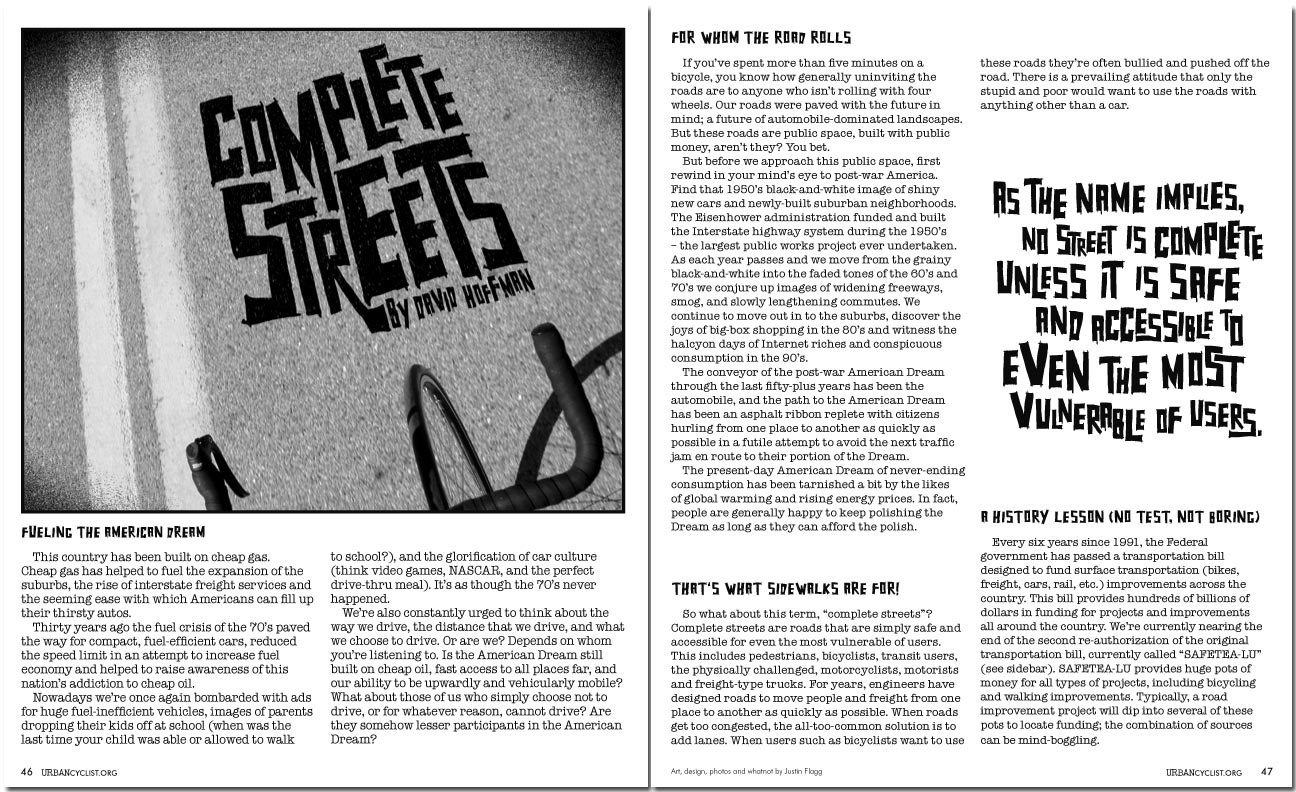
 |
Complete StreetsBy David Hoffman Fueling the American Dream This country has been built on cheap gas. Cheap gas has helped to fuel the expansion of the suburbs, the rise of interstate freight services and the seeming ease with which Americans can fill up their thirsty autos. Thirty years ago the fuel crisis of the 70’s paved the way for compact, fuel-efficient cars, reduced the speed limit in an attempt to increase fuel economy and helped to raise awareness of this nation’s addiction to cheap oil. Nowadays we’re once again bombarded with ads for huge fuel-inefficient vehicles, images of parents dropping their kids off at school (when was the last time your child was able or allowed to walk to school?), and the glorification of car culture (think video games, NASCAR, and the perfect drive-thru meal). It’s as though the 70’s never happened. We’re also constantly urged to think about the way we drive, the distance that we drive, and what we choose to drive. Or are we? Depends on whom you’re listening to. Is the American Dream still built on cheap oil, fast access to all places far, and our ability to be upwardly and vehicularly mobile? What about those of us who simply choose not to drive, or for whatever reason, cannot drive? Are they somehow lesser participants in the American Dream? For Whom The Road Rolls If you’ve spent more than five minutes on a bicycle, you know how generally uninviting the roads are to anyone who isn’t rolling with four wheels. Our roads were paved with the future in mind; a future of automobile-dominated landscapes. But these roads are public space, built with public money, aren’t they? You bet. But before we approach this public space, first rewind in your mind’s eye to post-war America. Find that 1950’s black-and-white image of shiny new cars and newly-built suburban neighborhoods. The Eisenhower administration funded and built the Interstate highway system during the 1950’s – the largest public works project ever undertaken. As each year passes and we move from the grainy black-and-white into the faded tones of the 60’s and 70’s we conjure up images of widening freeways, smog, and slowly lengthening commutes. We continue to move out in to the suburbs, discover the joys of big-box shopping in the 80’s and witness the halcyon days of Internet riches and conspicuous consumption in the 90’s. The conveyor of the post-war American Dream through the last fifty-plus years has been the automobile, and the path to the American Dream has been an asphalt ribbon replete with citizens hurling from one place to another as quickly as possible in a futile attempt to avoid the next traffic jam en route to their portion of the Dream. The present-day American Dream of never-ending consumption has been tarnished a bit by the likes of global warming and rising energy prices. In fact, people are generally happy to keep polishing the Dream as long as they can afford the polish. That’s What Sidewalks Are For! So what about this term, “complete streets”? Complete streets are roads that are simply safe and accessible for even the most vulnerable of users. This includes pedestrians, bicyclists, transit users, the physically challenged, motorcyclists, motorists and freight-type trucks. For years, engineers have designed roads to move people and freight from one place to another as quickly as possible. When roads get too congested, the all-too-common solution is to add lanes. When users such as bicyclists want to use these roads they’re often bullied and pushed off the road. There is a prevailing attitude that only the stupid and poor would want to use the roads with anything other than a car. A History Lesson (No Test, Not Boring) Every six years since 1991, the Federal government has passed a transportation bill designed to fund surface transportation (bikes, freight, cars, rail, etc.) improvements across the country. This bill provides hundreds of billions of dollars in funding for projects and improvements all around the country. We’re currently nearing the end of the second re-authorization of the original transportation bill, currently called “SAFETEA-LU” (see sidebar). SAFETEA-LU provides huge pots of money for all types of projects, including bicycling and walking improvements. Typically, a road improvement project will dip into several of these pots to locate funding; the combination of sources can be mind-boggling. |